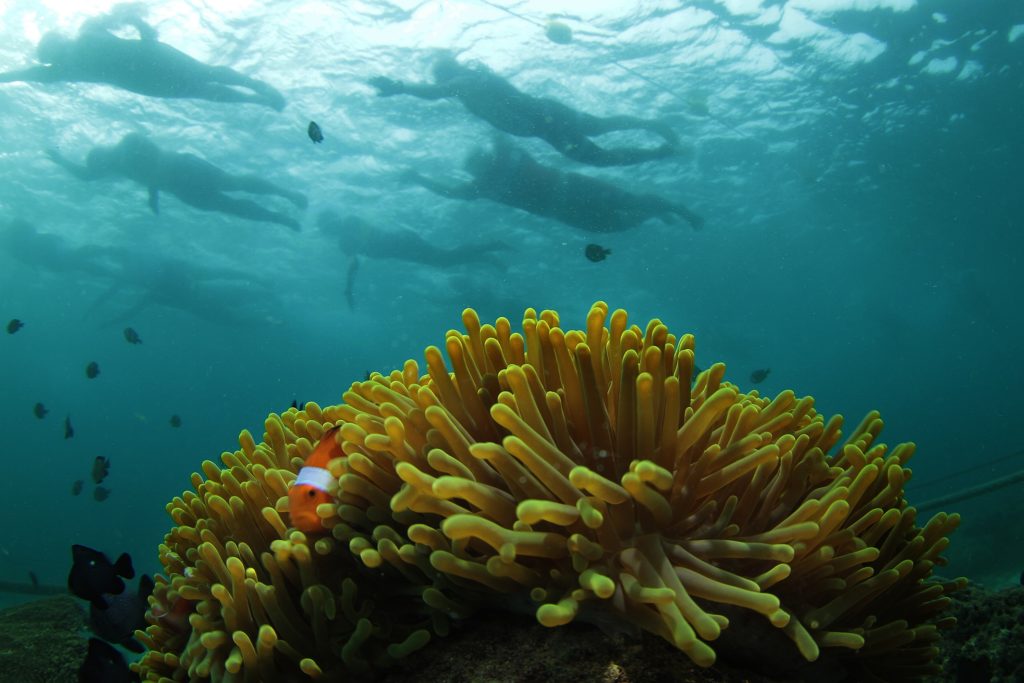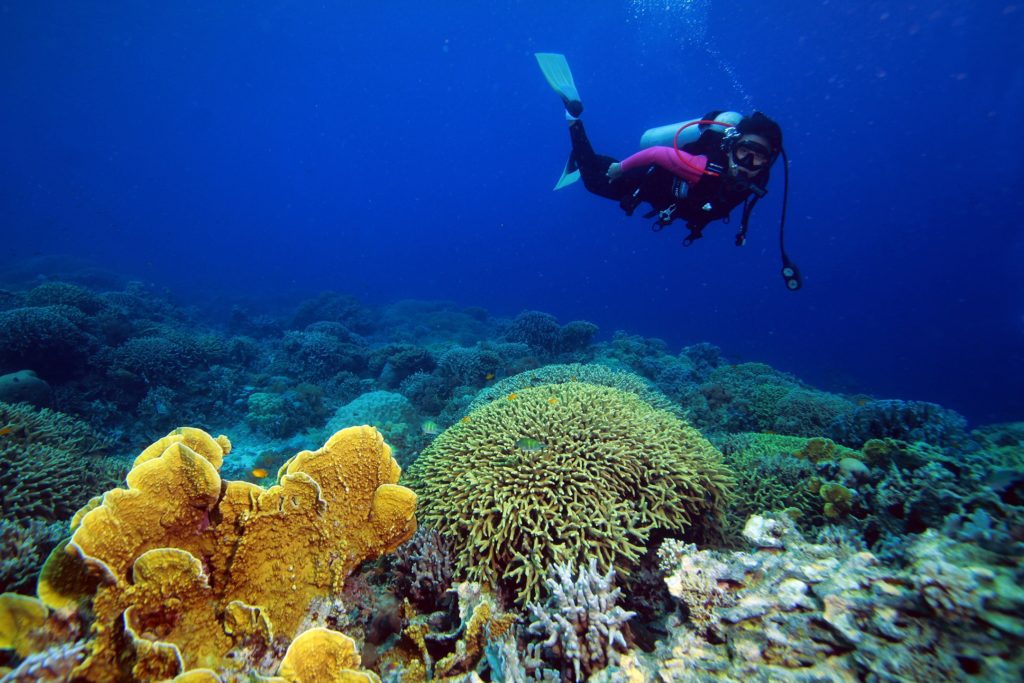
Swimmers pass over a patch of healthy corals during the swim leg of the Cobra Energy Drink Ironman 70.3 Asia Pacific Championship in this August 2016 photos (above, left photo, below, left) in Lapu Lapu City. Below, a diver enjoys the corals and rich underwater marine life in Sumilon Island in Oslob town in southern Cebu.
She was 7 years old when Aubrey Gail Mariano first found an interest in swimming.
“Everytime, I hold my breath and just go into the abyss, I feel freedom. I always feel belongingness when I’m underwater,” said Mariano, a fresh graduate of the University of San Carlos (USC) with a degree in Applied Linguistics.
For years, the 20-year-old freediver explored the underwater world and witnessed contemporary challenges experienced, over time, by coral reefs.
“I have been wandering the sea for quite a while now and I can always see plastic floating everywhere,” Mariano told Cebu Daily News.
With goggles on, Mariano said she could see plastic scattered all over the ocean floor trapped in corals and sea stones.
“These are mostly junk food wrappers or candy wrappers, diapers, plastic water bottles and straws,” she said.
Mariano feared that the trash would soon destroy the place she considers as her comfort zone.
“I am afraid that the sea cannot be explored anymore and it will turn into something restricted. Our once comfort will turn as our enemy. And our once home is no longer home anymore,” she said.
Plastic threat
Research Associate Professor Put Ang Jr. of the Chinese University in Hongkong said problems resulting from the use of plastic prevail as there are yet no solutions that would discourage its use.
“The problem is there is no alternative. Plastic is so widely used anywhere you go,” he said.
Ang, together with scientists, educators, and environmentalists from different countries gathered in Cebu for the Fourth Asia – Pacific Coral Reef Symposium (APCRS) last June 4 to 8, held at the Marco Polo Plaza Hotel.
Ang aired concern over biodegradable plastic which really only turns into micro plastic.
“They are not actually totally degraded. They are just being reduced to smaller sizes which (causes) the problem of micro plastic,” he said.
All these micro plastics still end up in the food chain.
“These things, that we are taking for granted for so long, are actually having a lot of impact,” added Ang while he called on the public to minimize the use of plastics.

UNDERWATER SUMILON ISLAND/AUGUST 28, 2016
A diver enjoyed the beautiful, lush coral garden of Sumilon Island in Oslob town, Cebu.
The Sumilon Marine Sanctuary is the first marine protected area in the Philippines and became a fish sanctuary in 1974 under Siliman University Marine Reserve’s guidance.
(CDN PHOTO/FERDINAND R. EDRALIN)
Coral reefs
Chou Loke Ming, president of the APCRS steering committee said that about 95 percent of coral reefs in Southeast Asia are under threat.
Based on the group’s assessment in 2011, overfishing and destructive fishing are the biggest factors that lead to the damage of coral reefs.
In Cebu, Lorenz Gideon Esmero of the Department of Environment and Natural Resources Coastal and Marine Ecosystem Management Program (DENR – CMEMP) said that coral reef conditions vary depending on location.
A survey conducted by CMEMP in 2017, showed that coral reefs in Oslob and Sibonga remained rich and the two southern Cebu towns had an abundance of marine life.
In Sibonga, about 80 percent of seawaters had live hard corals; while in Oslob, particularly in the seawaters of Sumilon Island, live corals covered at least 57 percent.
Meanwhile, in the seas of Medellin, northern Cebu, coral cover was considered “poor” at 25 percent, the CMEMP survey showed.
Esmero said corals usually live at a depth of between three to 40 meters below sea level, enough for sunlight to penetrate.
There are two types of corals, the live hard corals which secrete calcium carbonate and builds a reef ; and the soft corals which are not as useful, said Esmero.
“The more live corals there are, the more places for other corals to grow, “ Esmero said in Cebuano.

MACTAN UNDERWATER/NOV 1, 2016
A DIVER LOOKING ON A WHIP CORAL HANGING ON THE LEDGE 50 FEET BELOW THE WATER SURFACE NALUSUAN MARINE SANCTUARY IN LAPU-LAPU CITY.(CDN PHOTO/FERDINAND R. EDRALIN)
Aside from the colorful life forms underwater, Esmero emphasized the importance of coral reefs as fish habitat and as cushion for the damaging effect of waves.
“Dili kaayo na kusog ang hapak sa bawod. Wala lang na ma-appreciate sa fishermen (The waves don’t batter as much. Fishermen just don’t appreciate that.),” he said.
Corals are damaged due to natural calamities or irresponsible manmade actions such as illegal fishing and the discharge of waste water into the sea.
Challenges and solutions
Speaking at the forum, Senator Loren Legarda, chairperson of the senate committee on climate change, warned that throwing garbage into the sea and the failure to segregate waste, would
eventually result to the seas turning into “waste bins”.
“We look at our rivers and our lakes, and our waters and our oceans, as sanitary bins sometimes,” Legarda said.
Although, there are some environmental laws that aim to protect the seas and marine life such as Clean Water Act, Ecological Solid Waste Management Act of 2000, and National Integrated Protected Areas System (NIPAS), Legarda said these laws become useless if not strictly enforced by national government agencies.
Lergarda posed a challenge to national agencies, such as the DENR, Department of Agriculture (DA), and Bureau of Fisheries and Aquatic Resources (BFAR) to personally meet the local chief executives of the different localities and barangays to spread awareness on the importance of the marine environment.
Legarda also called on the public to be responsible citizens.
“We should have the greatest sense of responsibility and malasakit (concern) towards the environment which is the source of human life,” Legarda said.
Disclaimer: The comments uploaded on this site do not necessarily represent or reflect the views of management and owner of Cebudailynews. We reserve the right to exclude comments that we deem to be inconsistent with our editorial standards.
